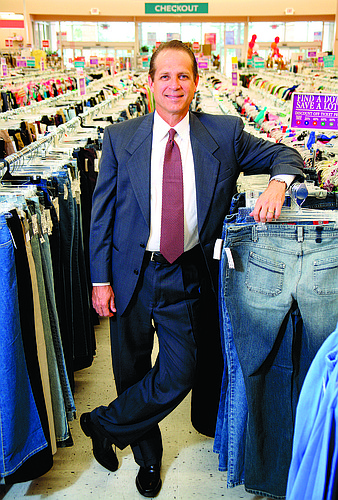Beall's, Inc. President and CEO Steve Knopik is not one to back away from a challenge. As a prep football star for Sarasota's Cardinal Mooney Cougars he played on its 1972 Class A state championship football team.
But now Knopik may be facing his biggest challenge yet when the 530-store Bradenton-based retail company he leads takes on higher state unemployment compensation (UC) tax rates on top of an already reeling retail landscape.
The minimum state UC tax rate changes Jan. 1 when it swells from $8.40 annually per employee to $100.30 — a 12-fold increase that will cost a company such as Beall's hundreds of thousands of dollars each year.
In 2012, it's forecast to peak at $192.95 per employee making it 23 times higher than today. In Florida, 241,783 companies, or 55%, pay at the minimum rate.
And the 0.8% federal UC tax rate is forecast to more than double from 2010 to 2013.
Although the first higher UC tax payments come due in April, companies trying to budget for 2010 are just finding out this week what rates to build budgets around.
“It's a very difficult time for business to be faced with a change of this magnitude,” says Knopik. Beall's, with about 8,100 of its employees in 329 Florida stores, has enjoyed relatively low UC tax rates based on its low employee turnover experience.
The maximum rate, paid by more than 80,000 companies, stays at 5.4%. But a legislated increase in the wage base to which the rate is applied increases the maximum cost per employee from $378 to $459, or by 21.4%. New employers, nearly 64,000, get the same percent increase while continuing to pay a 2.7% UC rate until it's adjusted based on eight quarters of experience — meaning accounting for how many workers became eligible for unemployment benefits.
With 1,027,000 unemployed across the state, out of a labor force of 9,175,000, the burden is on fewer companies to be their brother's keeper. Or their competitor's keeper.
But untimely tax increases on business during a recession are not exactly a job creation plan.
David Daniel, the Florida Chamber of Commerce's vice president of government affairs, has a blog dedicated to the subject asking for members to provide feedback. Putting it all in perspective, he says, “We're really in uncharted waters.”
And navigating out of it will be no easy task because of the vicious cycle created by higher taxes on businesses leading to more layoffs and higher rates again. “This is really a big increase on Florida employers when we can least afford it. It's only going to exacerbate the struggle and put more people out of work,” Daniel warns.
Knopik calls it a death spiral. “You're taxing at such a high rate it's going to create more job losses,” he predicts.
Statewide it adds up to an extra $1.2 billion Florida businesses will collectively lose off the bottom line in 2010 — money that cannot be reinvested for jobs and economic growth.
The state projects an additional $482 million going into the fund in 2011 bringing the total UC tax collections to nearly $2.6 billion. It's projected to take until 2015 before enough employment growth allows state rates to settle back below 1%.
Companies that have managed to retain or grow jobs and have minimum rates now face the challenge of this major tax increase to pay the unemployment benefits traceable to others — maybe even competitors.
The 1,100% increase scream
“They get penalized for the layoffs of other industries,” says Julie Bynum, a CPA and tax manager at accounting firm Kerkering Barberio in Sarasota.
Bynum also notes that letters from the Florida Department of Revenue were scheduled to go out in mid-December advising companies of the new rates.
Concerned about how few small business people are aware of the changes, she's anticipating clients' negative reaction. “I think we're going to hear the screaming in the next couple weeks.”
Here's why: the minimum rate is changing from 0.12% applied to the first $7,500 of taxable wages to 1.18% applied to the first $8,500 of wages. Those changes and other business busting details are part of Senate Bill 810 adopted during the 2009 regular session last spring and signed by Gov. Charlie Crist.
Daniel's blog provides an example of a 50-employee company with the minimum experience rating. Such a company paid $420 in state unemployment taxes in 2009. With the changes in the base and rates the same company will now pay $5,015 in 2010, a 1,094% increase.
The legislation anticipated that the state's one-time $2.1 billion unemployment trust fund, which had dropped to $1.3 billion at the end of 2008, would run out of money, which it did Aug. 24.
So the state borrowed roughly $300 million a month from Uncle Sam to pay rising unemployment benefits, leaving Florida owing the feds $737.7 million.
“Never did we expect we'd go from $2 billion in a fund to zero,” says Sen. Nancy Detert, R-Venice, one of three Gulf Coast legislators sitting on the Senate Commerce Committee. The two other area committee members, Sen. Charlie Justice, D-St. Petersburg, and Sen. Victor Crist, R-Tampa, did not respond to a request for comment.
The trust fund balance will remain at zero until at least 2013 because what's coming into the fund is going right back out in benefits payments, according to Lisa Echeverri, executive director of the Department of Revenue.
Echeverri appeared before the committee Dec. 7 to give what she phrased as the “high school explanation” of the rate changes.
One bewildered member, former Alachua County Sheriff Sen. Steve Oelrich, R-Gainesville, told her it was “a high school explanation of a middle school question.”
It may not come as much comfort to lawmakers, but Florida is now but one of 26 states sinking in red ink in the same federal loan lifeboat totaling $22.2 billion in federal advances. Another 14 states are expected to jump aboard by mid-2010.
Pulling policy triggers
The state's unemployment rate hit 11.2% in October after only days earlier another legislative committee was told by staff not to expect until spring that high an unemployment rate. Now, according to the latest figures from the Nov. 3 Florida Economic Estimating Conference, the unemployment rate is expected to rise to 11.4% for the second and third quarters of 2010 before returning to 11.2% in the fourth quarter. It doesn't drop below 10% until the first quarter of 2012.
All that unemployment means more unemployment benefits to pay out. And when the UC tax rates are recalculated based on the June 30 data, they're projected to rise further. The minimum rate is projected to max out at 2.27% in 2012, but doesn't get back to the 2009 rate of 0.12% at least through 2019 when it's forecast to be at 0.44%.
Those increases come from automatic adjustment factors or “triggers” built into section 443.131 of Florida Statutes designed to keep the fund between 4% and 5% of total taxable state payroll. Last June, the balance of the state UC trust fund fell to $450 million, well below the required 4% of the state's $50 billion taxable payroll, thus triggering the Jan. 1 adjustment.
When the balance exceeds 5% of total state payroll a negative trigger normally reduces the rates, but under the 2009 legislation that won't happen until Jan. 1, 2015. The legislation also requires the taxable wage base to revert back to $7,000 on the same date.
All of these rules are subject to change by the Legislature.
Another factor pushing up the rates is that the Legislature wanted to replenish the fund sooner rather than later to minimize the amount of interest paid at a 5% rate to the feds for the borrowing, but more importantly for businesses, minimize forecasted increases in the federal rate.
Currently, states meeting federal requirements get the 6.2% federal rate reduced to 0.8%. If the loan were to become delinquent, the federal rate would increase by 0.3% annually until the state catches up.
A recently released state forecast from the Legislature's office of economic and demographic research shows the fed rate rising to 1.1% in 2011, 1.4% in 2012 and 1.7% in 2013 before falling back to 0.8% in 2014.
Thus, employers will likely face multiple tax increases: one from the state to restore the solvency of the state trust fund and another from the feds to repay the loans. In 2013, the combined state and federal minimum rates peak, according to the state forecast. The 50-employee company paying the minimum would then pay a total of $15,342.50 nearly five times the amount paid in 2009.
It was a “pay me now, or pay me later” policy decision for the 2009 Legislature that may be revisited in the 2010 regular session.
Sen. Rudy Garcia, R-Hialeah, chairman of the commerce committee, expects UC taxes to be on the 2010 session agenda. “We have a policy question we may need to address,” he told his committee. “We never had to deal with this before.”
The Florida Chamber and the Florida Retail Federation want the $8,500 wage base brought back to $7,000. “We're trying to soften the blow to Florida employers who can't take the hit right now,” says Daniel. “Yes, all of the business associations are working to lower the increase. The easiest way is to suspend the trigger and reduce the wage base.”
Beall's Knopik agrees reversing the wage base would help. However, he argues, “The base change is just a fraction of the problem; if you look at the rate, goodness gracious!”
Garcia, probably one of the most knowledgeable legislators on the issue, told his committee he fears the unemployment rate and the need for UC tax revenue “will continue to go up.” His parting words: “We have a lot of work ahead of us, and I don't know how we're going to get there.”
Knopik is willing to offer a few words of advice for legislators: “My suggestion is that the Legislature try to identify approaches to this challenge, to try to defer the imposition of the tax down the road a bit, and give time for the economy to recover. And as job growth begins to emerge again, then they're going to have a broader base to deal with.”
With so much now at stake for Beall's and all Florida businesses, state champion Knopik and other business leaders will need to put their game face on to be effective champions for the state and for business.
Review Summary
What. Unemployment compensation tax rates shoot up Jan. 1.
Issue. State unemployment compensation trust fund wiped out, leaving few choices for legislators.
Impact. Florida employers will pay $1.2 billion more into the fund in 2010, and more later as state and federal rates rise.
AT A GLANCE
2010 State Unemployment Compensation Tax Rates Basics
Statutory changes enacted in 2009 increased an employee's taxable wages from $7,000 to $8,500 for the 2010 rates.
Current rates (based on annual salary up to $7,000 per employee):
Minimum rate: 0.0012 or $8.40 per employee
Maximum rate: 0.0540 or $378 per employee
New rates effective Jan. 1, 2010 (based on annual salary up to $8,500 per employee):
Minimum rate: 0.0118 or $100.30 per employee
Maximum rate: 0.0540 or $459 per employee
Notices of business's individual rates will be distributed in December 2009 and are effective for wages paid on or after Jan. 1, 2010.
Source: Florida Department of Revenue.
To see the Unemployment Compensation Tax Rates Soaring by the numbers, download it here. ByTheNumbers.pdf
Jay Brady covers state and local government issues. He can be reached at [email protected], or at 941-362-4848.






